A review of current analytical methods for the determination of prebiotics in foods
Prebiotics are a group that improves the human intestinal microbiota. The relationship
between prebiotics and human health has been an area of increasing interest in recent years.
Fructo-oligosaccharides and galacto-oligosaccharides are the two important groups of
prebiotics with beneficial effects on human health. Besides that, more and more carbohydrates
have shown a good potential to be prebiotics has been studied. This study presents a review of
the characteristics, properties, and analytical methods used for the determination of prebiotics
in food products. Most of the methods found using chromatographic methods, especially
HPAEC - PAD but also another method, such as spectrometric methods have been presented.
A discussion was presented highlighting the drawbacks of current analytical methods and the
need to develop these methods to analyze the complex food samples containing prebiotics.
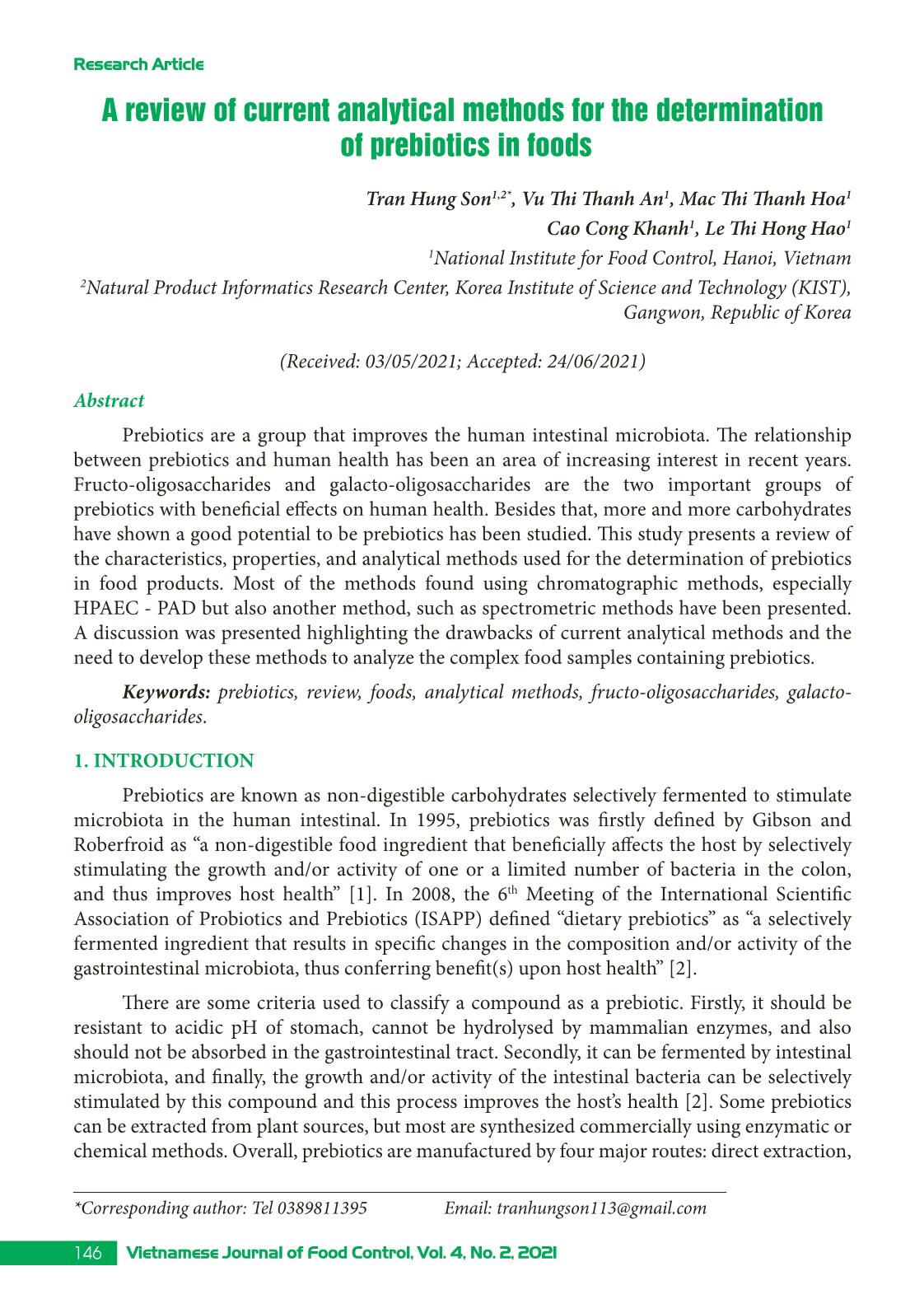
Trang 1
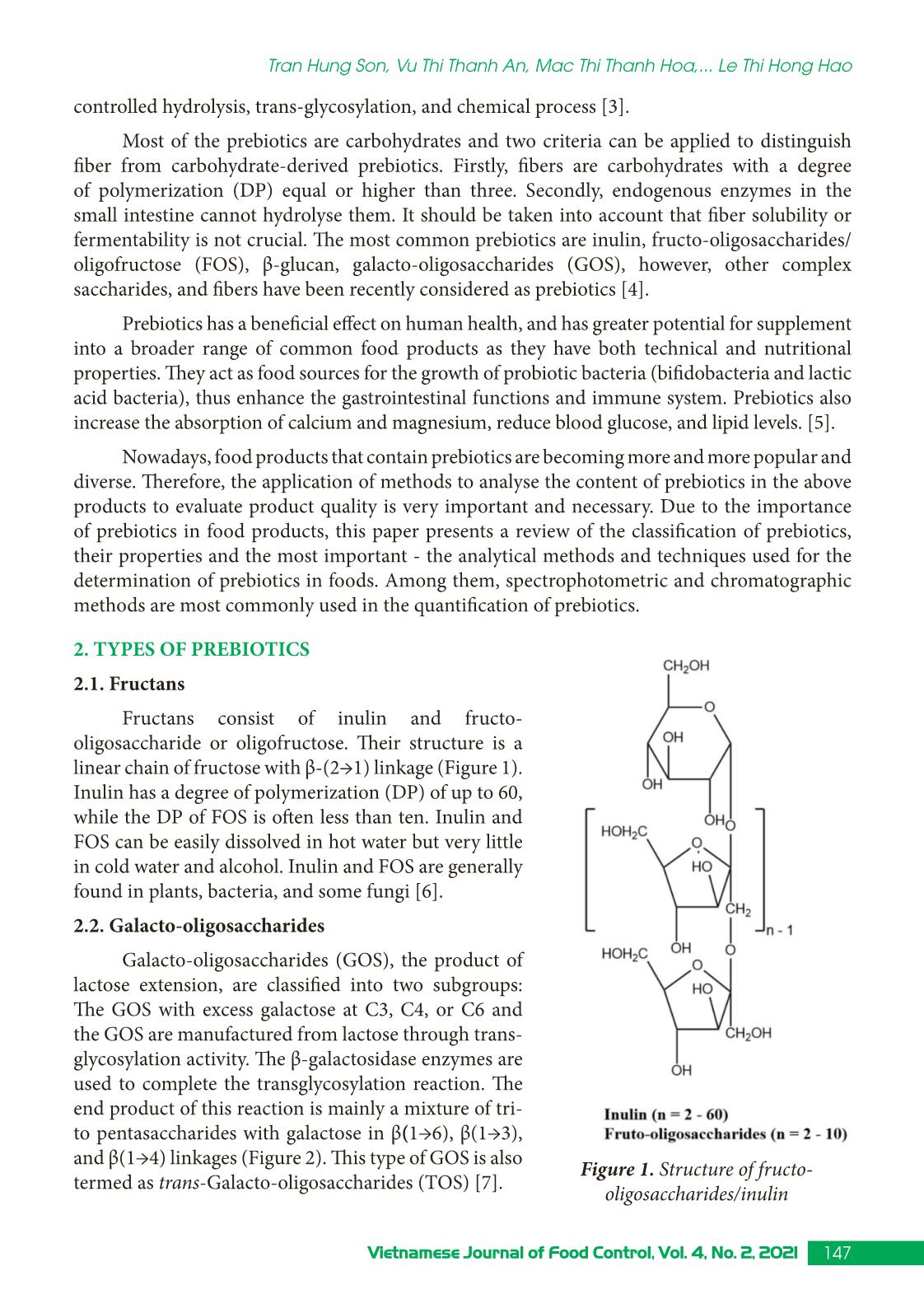
Trang 2
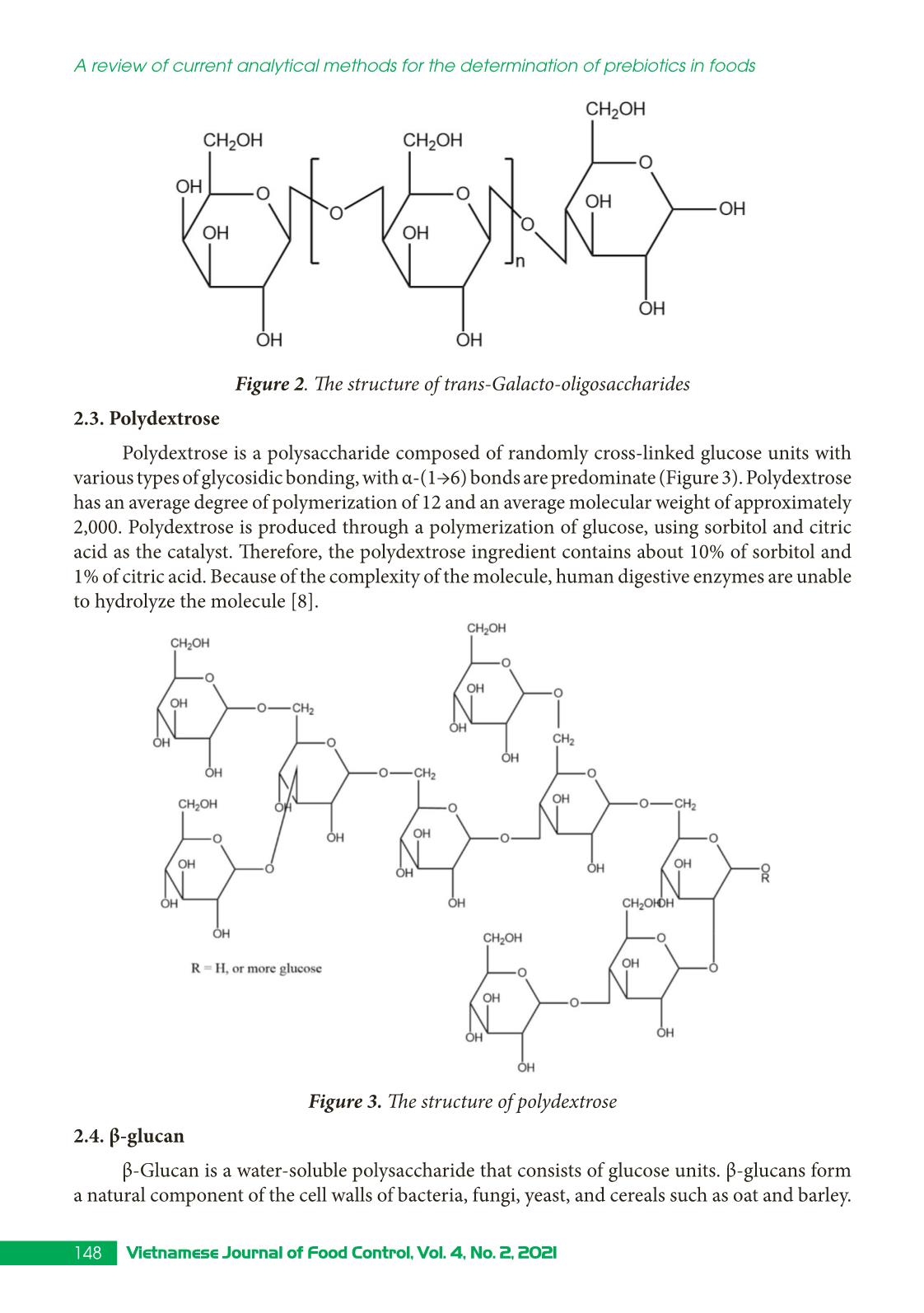
Trang 3

Trang 4

Trang 5
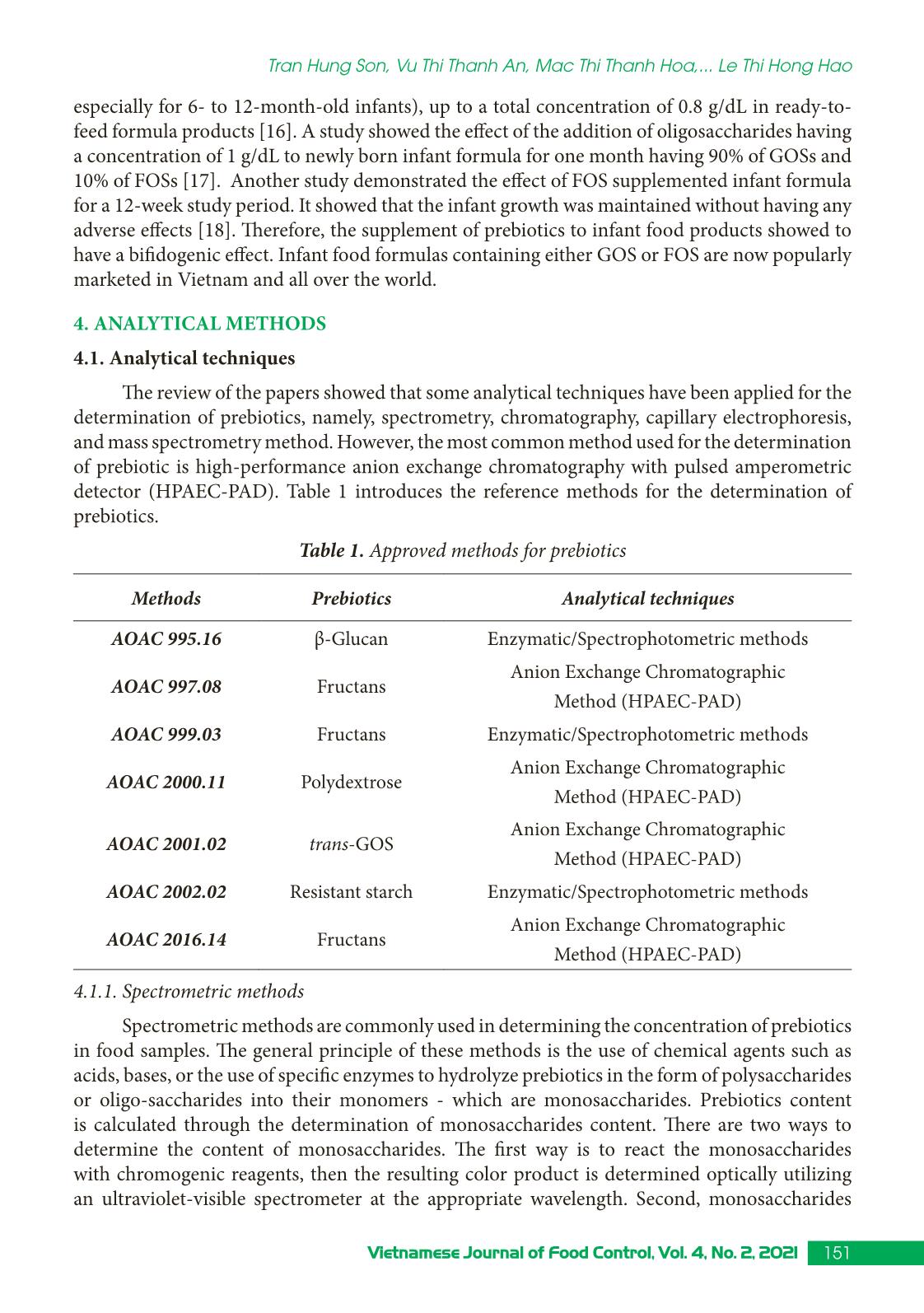
Trang 6

Trang 7
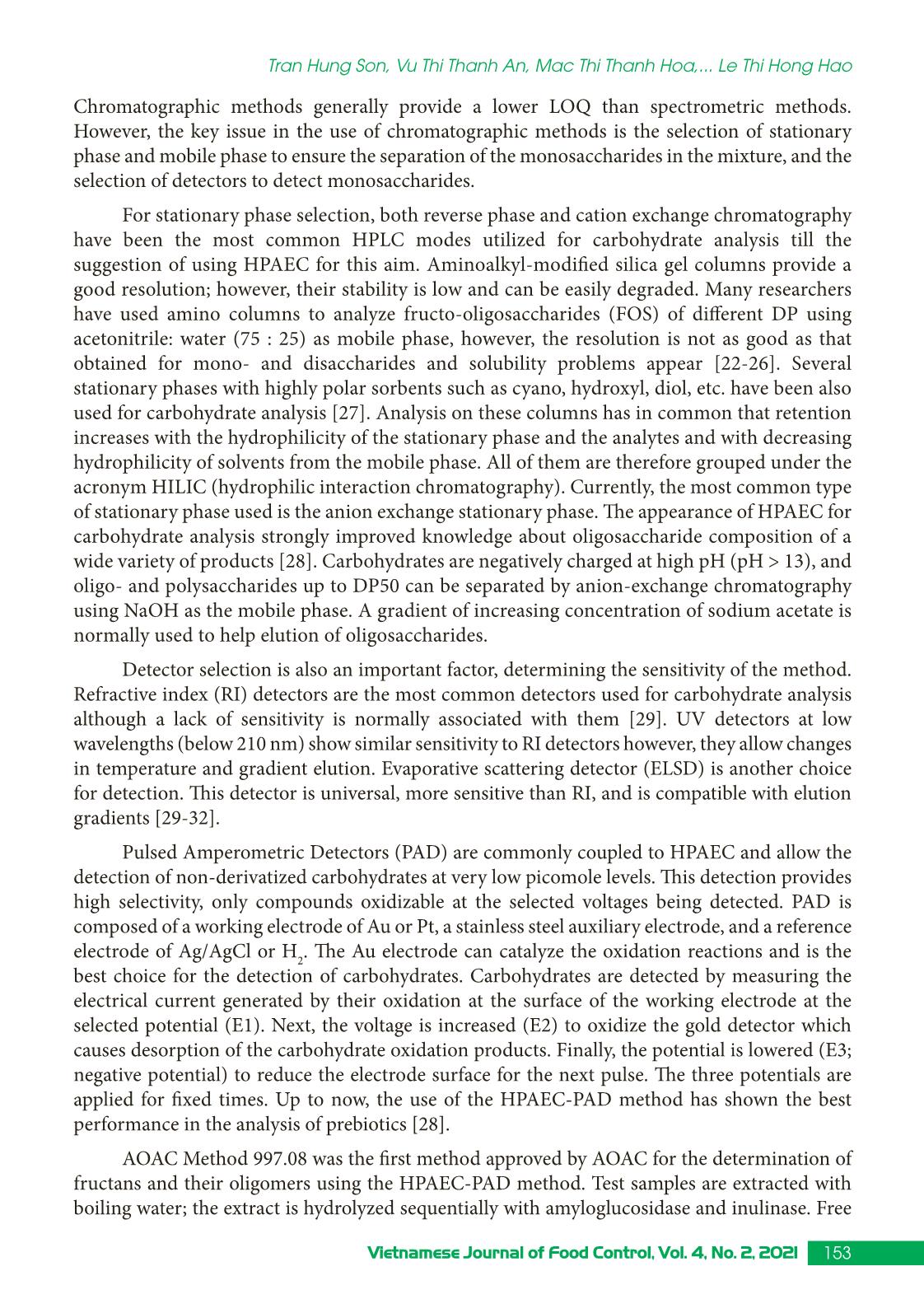
Trang 8
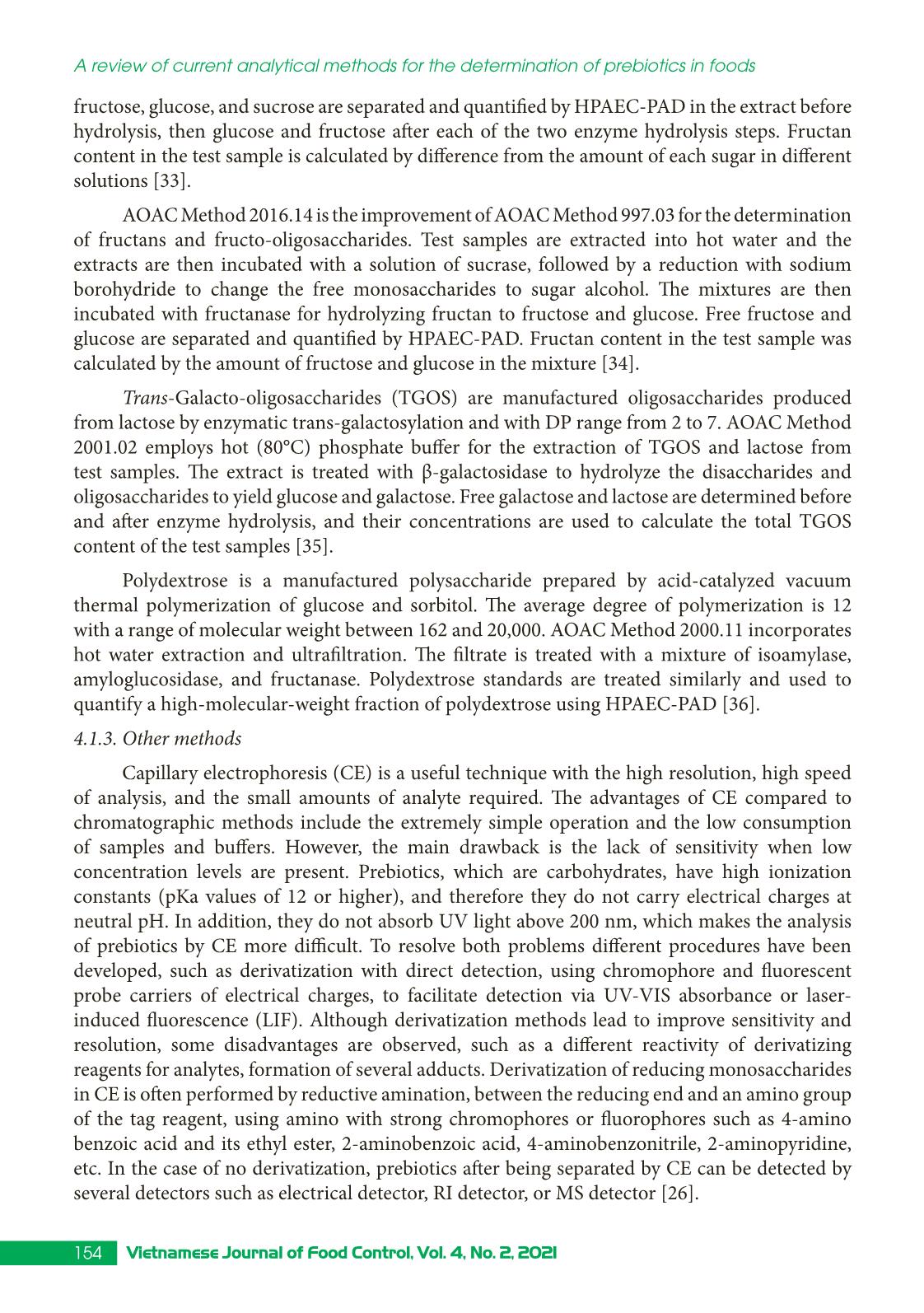
Trang 9
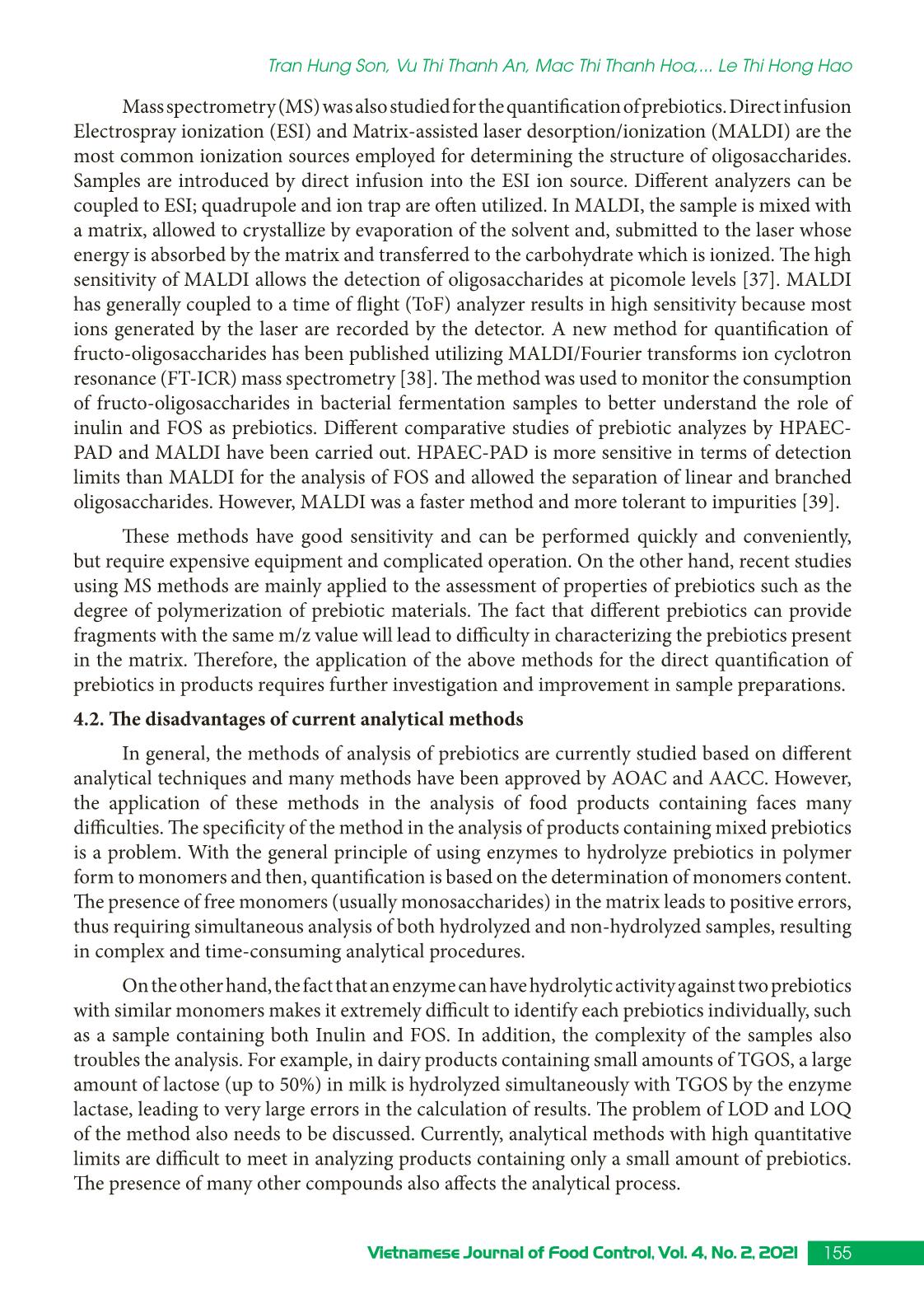
Trang 10
Tải về để xem bản đầy đủ
Tóm tắt nội dung tài liệu: A review of current analytical methods for the determination of prebiotics in foods
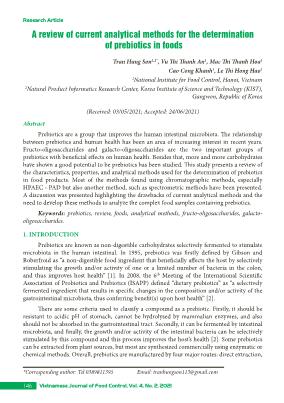
Research Article 146 Vietnamese Journal of Food Control, Vol. 4, No. 2, 2021 A review of current analytical methods for the determination of prebiotics in foods Tran Hung Son1,2*, Vu Thi Thanh An1, Mac Thi Thanh Hoa1 Cao Cong Khanh1, Le Thi Hong Hao1 1National Institute for Food Control, Hanoi, Vietnam 2Natural Product Informatics Research Center, Korea Institute of Science and Technology (KIST), Gangwon, Republic of Korea (Received: 03/05/2021; Accepted: 24/06/2021) Abstract Prebiotics are a group that improves the human intestinal microbiota. The relationship between prebiotics and human health has been an area of increasing interest in recent years. Fructo-oligosaccharides and galacto-oligosaccharides are the two important groups of prebiotics with beneficial effects on human health. Besides that, more and more carbohydrates have shown a good potential to be prebiotics has been studied. This study presents a review of the characteristics, properties, and analytical methods used for the determination of prebiotics in food products. Most of the methods found using chromatographic methods, especially HPAEC - PAD but also another method, such as spectrometric methods have been presented. A discussion was presented highlighting the drawbacks of current analytical methods and the need to develop these methods to analyze the complex food samples containing prebiotics. Keywords: prebiotics, review, foods, analytical methods, fructo-oligosaccharides, galacto- oligosaccharides. 1. INTRODUCTION Prebiotics are known as non-digestible carbohydrates selectively fermented to stimulate microbiota in the human intestinal. In 1995, prebiotics was firstly defined by Gibson and Roberfroid as “a non-digestible food ingredient that beneficially affects the host by selectively stimulating the growth and/or activity of one or a limited number of bacteria in the colon, and thus improves host health” [1]. In 2008, the 6th Meeting of the International Scientific Association of Probiotics and Prebiotics (ISAPP) defined “dietary prebiotics” as “a selectively fermented ingredient that results in specific changes in the composition and/or activity of the gastrointestinal microbiota, thus conferring benefit(s) upon host health” [2]. There are some criteria used to classify a compound as a prebiotic. Firstly, it should be resistant to acidic pH of stomach, cannot be hydrolysed by mammalian enzymes, and also should not be absorbed in the gastrointestinal tract. Secondly, it can be fermented by intestinal microbiota, and finally, the growth and/or activity of the intestinal bacteria can be selectively stimulated by this compound and this process improves the host’s health [2]. Some prebiotics can be extracted from plant sources, but most are synthesized commercially using enzymatic or chemical methods. Overall, prebiotics are manufactured by four major routes: direct extraction, *Corresponding author: Tel 0389811395 Email: tranhungson113@gmail.com 147Vietnamese Journal of Food Control, Vol. 4, No. 2, 2021 Tran Hung Son, Vu Thi Thanh An, Mac Thi Thanh Hoa,... Le Thi Hong Hao controlled hydrolysis, trans-glycosylation, and chemical process [3]. Most of the prebiotics are carbohydrates and two criteria can be applied to distinguish fiber from carbohydrate-derived prebiotics. Firstly, fibers are carbohydrates with a degree of polymerization (DP) equal or higher than three. Secondly, endogenous enzymes in the small intestine cannot hydrolyse them. It should be taken into account that fiber solubility or fermentability is not crucial. The most common prebiotics are inulin, fructo-oligosaccharides/ oligofructose (FOS), β-glucan, galacto-oligosaccharides (GOS), however, other complex saccharides, and fibers have been recently considered as prebiotics [4]. Prebiotics has a beneficial effect on human health, and has greater potential for supplement into a broader range of common food products as they have both technical and nutritional properties. They act as food sources for the growth of probiotic bacteria (bifidobacteria and lactic acid bacteria), thus enhance the gastrointestinal functions and immune system. Prebiotics also increase the absorption of calcium and magnesium, reduce blood glucose, and lipid levels. [5]. Nowadays, food products that contain prebiotics are becoming more and more popular and diverse. Therefore, the application of methods to analyse the content of prebiotics in the above products to evaluate product quality is very important and necessary. Due to the importance of prebiotics in food products, this paper presents a review of the classification of prebiotics, their properties and the most important - the analytical methods and techniques used for the determination of prebiotics in foods. Among them, spectrophotometric and chromatographic methods are most commonly used in the quantification of prebiotics. 2. TYPES ... he degree of polymerization of prebiotic materials. The fact that different prebiotics can provide fragments with the same m/z value will lead to difficulty in characterizing the prebiotics present in the matrix. Therefore, the application of the above methods for the direct quantification of prebiotics in products requires further investigation and improvement in sample preparations. 4.2. The disadvantages of current analytical methods In general, the methods of analysis of prebiotics are currently studied based on different analytical techniques and many methods have been approved by AOAC and AACC. However, the application of these methods in the analysis of food products containing faces many difficulties. The specificity of the method in the analysis of products containing mixed prebiotics is a problem. With the general principle of using enzymes to hydrolyze prebiotics in polymer form to monomers and then, quantification is based on the determination of monomers content. The presence of free monomers (usually monosaccharides) in the matrix leads to positive errors, thus requiring simultaneous analysis of both hydrolyzed and non-hydrolyzed samples, resulting in complex and time-consuming analytical procedures. On the other hand, the fact that an enzyme can have hydrolytic activity against two prebiotics with similar monomers makes it extremely difficult to identify each prebiotics individually, such as a sample containing both Inulin and FOS. In addition, the complexity of the samples also troubles the analysis. For example, in dairy products containing small amounts of TGOS, a large amount of lactose (up to 50%) in milk is hydrolyzed simultaneously with TGOS by the enzyme lactase, leading to very large errors in the calculation of results. The problem of LOD and LOQ of the method also needs to be discussed. Currently, analytical methods with high quantitative limits are difficult to meet in analyzing products containing only a small amount of prebiotics. The presence of many other compounds also affects the analytical process. 156 Vietnamese Journal of Food Control, Vol. 4, No. 2, 2021 A review of current analytical methods for the determination of prebiotics in foods 5. CONCLUSIONS Prebiotics, which have shown many positive effects on human health, especially the improvement in human intestinal microbiota. This review paper has shown that a variety of analytical methods for the identification and determination of prebiotics have been developed and described. The most common analytical methods and techniques used for determination of prebiotics group are spectrometric methods and chromatographic methods. Spectrophotometric methods have several advantages, such as good analytical specificity and they are easier, less expensive compared with the other methods. However, the spectrophotometric methods are less sensitive than other methods. Chromatographic methods, especially HPAEC-PAD are most commonly used for the quantification of prebiotics. Chromatographic methods generally provide a lower limit of quantification. However, the key issue in the use of chromatographic methods is the separation of the monosaccharides in the mixture after hydrolysis of prebiotics. A major problem with current analytical methods is their efficiency in analyzing a mixture of prebiotics present in food samples. In addition, the removal of other compounds which hydrolyzed along with prebiotics in the sample preparation step is also an unresolved problem. Therefore, in the following years, it is very important to develop quantitative analytical methods for prebiotics in food that can provide a useful tool for assessing the quality of food products that contains prebiotics. REFERENCES [1]. G. R. Gibson, and M. B. Roberfroid, “Dietary modulation of the human colonic microbiota: introducing the concept of prebiotics,” Journal of Nutrition, vol.125, no.6, pp. 1401-1412, 1995. [2]. G. Gibson, K. Scott; R. Rastall, K. Tuohy, A. Hotchkiss, A. Dubert-Ferrandon, M. Gareau, E. Murphy, D. Saulnier, Gunnar Loh, S. Macfarlane, N. Delzenne, Y. Ringel, G. Kozianowski, R. Dickmann, I. Lenoir-Wijnkoop, C. Walker, and R. Buddington, “Dietary prebiotics: current status and new definition,” Food Science and Technology Bulletin: Functional Foods, vol. 7, no.1, pp. 1-19, 2010. [3]. Y. K. Lee and S. Salminen, Handbook of probiotics and prebiotics, 2009. [4]. J. F. Howlett, V. A. Betteridge, M. Champ, S. A.S. Craig, A. Meheust, and J. M. Jones, “The definition of dietary fiber - discussions at the Ninth Vahouny Fiber Symposium: building scientific agreement,” Food & Nutrition Reseach, vol. 54, 2010. [5]. K. Younis, S. Ahmad, and K Jahan, “Health benefits and application of prebiotics in foods,” Journal of Food Processing & Technology, vol.6, no.4, pp. 1-7, 2015. [6]. P. Louis, H. J. Flint, and C. Michel, “How to Manipulate the Microbiota: Prebiotics,” Advance in Experimental Medecine and Biology, vol. 902, pp. 119-142, 2016. [7]. G. T. Macfarlane, H. Steed, and S. Macfarlane, “Bacterial metabolism and health-related effects of galacto-oligosaccharides and other prebiotics,” Journal of Applied Microbiology, vol.104, no.2, pp. 305-344, 2008. [8]. M. M. Ramiro do Carmo, J. C. L. Walker, D. Novello, V. M. Caselato, V. C. Sgarbieri, A. C. Ouwehand, N. A. Andreollo, P. A. Hiane, and E. Freitas Dos Santos, “Polydextrose: Physiological function, and effects on health,” Nutrients, vol. 8, no.9, pp. 553, 2016. [9]. B. A. Stone, “Chemistry of β-glucans,” Chemistry, Biochemistry, and Biology of 1-3 Beta Glucans and Related Polysaccharides, Elsevier, pp. 5-46, 2009. [10]. J. Knol, G. Boehm, M. Lidestri, F. Negretti, J. Jelinek, M. Agosti, B. Stahl, A. Marini, 157Vietnamese Journal of Food Control, Vol. 4, No. 2, 2021 Tran Hung Son, Vu Thi Thanh An, Mac Thi Thanh Hoa,... Le Thi Hong Hao and Fabio Mosca, “Increase of faecal bifidobacteria due to dietary oligosaccharides induces a reduction of clinically relevant pathogen germs in the faeces of formula-fed preterm infants,” Acta Paediatrica Supplement, vol. 94, no. 449, pp. 31-33, 2005. [11]. A. L. McCartney and G. R. Gibson, “The normal microbiota of the human gastrointestinal tract: history of analysis, succession, and dietary influences,” Gastrointestinal Microbiology, pp. 51-73, 2006. [12]. D. B. Silk, A. Davis, J. Vulevic, G. Tzortzis, and G. R. Gibson, “Clinical trial: the effects of a trans-galactooligosaccharide prebiotic on faecal microbiota and symptoms in irritable bowel syndrome,” Alimentary Pharmacology & Therapeutics, vol. 29, no. 5, pp. 508-518, 2009. [13]. J. O. Lindsay, K. Whelan, A. J. Stagg, P. Gobin, H. O. Al-Hassi, N. Rayment, M. A. Kamm, S. C. Knight, and A Forbes, “Clinical, microbiological, and immunological effects of fructo- oligosaccharide in patients with Crohn’s disease,” Gut, vol. 55, no. 3, pp. 348-355, 2006. [14]. A. Böhm, I. Kaiser, A. Trebstein, and T. Henle, “Heat-induced degradation of inulin,” European Food Research and Technology, vol. 220, no. 5, pp. 466-471, 2005. [15]. S. M. Donovan, “Role of human milk components in gastrointestinal development: current knowledge and future needs,” The Journal of Pediatrics, vol. 149, no. 5, pp. S49-S61, 2006. [16]. G. Veereman-Wauters, S. Staelens, H. Van de Broek, K. Plaskie, F. Wesling, L. C. Roger, A. L. McCartney, and P. Assam, “Physiological and bifidogenic effects of prebiotic supplements in infant formulae”, Journal of Pediatric Gastroenterology Nutrition, vol. 52, no. 6, pp. 763- 771, 2011. [17]. G. Boehm, M. Lidestri, P. Casetta, J. Jelinek, F. Negretti, B. Stahl, and A Marini, “Supplementation of a bovine milk formula with an oligosaccharide mixture increases counts of faecal bifidobacteria in preterm infants,” Archives of Disease in Childhood. Fetal and Neonatal Edition, vol. 86, no. 3, pp. F178-181, 2002. [18]. P. A. M. J. Scholtens, M. S. Alles, J. G. Bindels, E. G. M van der Linde, J. J. M. Tolboom, and J.Knol, “Bifidogenic effects of solid weaning foods with added prebiotic oligosaccharides: a randomised controlled clinical trial,” Journal of Pediatric Gastroenterology Nutriton, vol.42, no.5, pp. 553-559, 2006. [19]. B. V. McCleary, A. Murphy, and D. C. Mugford, “Measurement of total fructan in foods by enzymatic/spectrophotometric method: collaborative study,” Journal of AOAC International, vol. 83, no. 2, pp. 356-364, 2000. [20]. B. V. McCleary and R. Codd, “Measurement of (1→ 3),(1→ 4)-β-D-glucan in barley and oats: A streamlined enzymic procedure,” Journal of the Science of Food and Agriculture, 55(2), pp. 303-312, 1991. [21]. B. V. McCleary and D. A. Monaghan, “Measurement of resistant starch,” Journal of AOAC International, vol. 85, no. 3, pp. 665-675, 2002. [22]. H. Ding, C. Li, P. Jin, L. Yuan, Y. Yao, Y. Chen, and Pei Li, “Simultaneous determination of monosaccharides, disaccharides, oligosaccharides and sugar alcohols in foods by high performance liquid chromatography with evaporative light-scattering detection,” Se Pu, vol. 31, no. 8, pp. 804-808, 2013. [23]. R. Rodriguez-Gomez, I. Jimenez-Diaz, A. Zafra-Gomez, and J. C. Morales, “Improved sample treatment for the determination of fructooligosaccharides in milk related products by liquid chromatography with electrochemical and refractive index detection”, Talanta, vol. 144, pp. 883-889, 2015. [24]. J. Li, D. Hu, W. Zong, G. Lv, J. Zhao, and S. Li, “Determination of inulin-type fructooligosaccharides in edible plants by high-performance liquid chromatography with 158 Vietnamese Journal of Food Control, Vol. 4, No. 2, 2021 A review of current analytical methods for the determination of prebiotics in foods charged aerosol detector”, Journal of Agriculture and Food Chemistry, vol. 62, no. 31, pp. 7707-7713, 2014. [25]. J. Li, X. Liu, B. Zhou, J. Zhao, and S. Li, “Determination of fructooligosaccharides in burdock using HPLC and microwave-assisted extraction”, Journal of Agriculture and Food Chemistry, vol. 61, no. 24, pp. 5888-5892, 2013. [26]. M. L. Sanz, AI. Ruiz-Matute, N. Corzo, and I. Martínez-Castro, “Analysis of prebiotic oligosaccharides,” Prebiotics and Probiotics Science and Technology, pp. 465-534, 2009. [27]. T. Ikegami, K. Tomomatsu, H. Takubo, K. Horie, and N. Tanaka, “Separation efficiencies in hydrophilic interaction chromatography,” Journal of chromatography A, vol. 1184, no. 1-2, pp. 474-503, 2008. [28]. R. D. Rocklin and C. A. Pohl, “Determination of carbohydrates by anion exchange chromatography with pulsed amperometric detection,” Journal of Liquid Chromatography, vol. 6, no. 9, pp. 1577-1590, 1983. [29]. M. J. Davies and E. F. Hounsell, “Carbohydrate chromatography: towards yoctomole sensitivity,” Biomedical Chromatography, vol. 10, no. 6, pp. 285-289, 1996. [30]. M. Gohlke and V. Blanchard, “Separation of N-glycans by HPLC,” Methods in Molecular Biology, vol. 446, pp. 239-254, 2008. [31]. S. Hase, “Pre-and post-column detection-oriented derivatization techniques in HPLC of carbohydrates,” Journal of Chromatography Library, Elsevier, pp. 555-575,1995. [32]. B. Herbreteau, “Review and state of sugar analysis by high performance liquid chromatography,” Analusis (Imprimé), vol. 20, no. 7, pp. 355-374, 1992. [33]. H. Hoebregs and Collaborators: Balis P De Vries J Eekelen J v Farnell P Gray K Goedhuys B Hermans M Heroff J van Leeuwen M Li BW Martin D Pieters M Quemener B Roomans, “Fructans in foods and food products, ion-exchange chromatographic method: collaborative study,” Journal of AOAC International, vol. 80, no. 5, pp. 1029-1039, 1997. [34]. V. Spichtig, S. Austin, K. Brunt, J. Van Soest, and P. Sanders, “Determination of Fructans in Infant Formula and Adult/Pediatric Nutritional Formula by Anion-Exchange Chromatography with Pulsed Amperometric Detection after Enzymatic Treatment: Collaborative Study, Final Action 2016.14,” Journal of AOAC International, vol. 103, no. 5, pp. 1301-1317, 2020. [35]. J. D. Slegte, “Determination of trans-galactooligosaccharides in selected food products by ion-exchange chromatography: collaborative study,” Journal of AOAC International, vol. 85, no. 2, pp. 417-423, 2002. [36]. S. A. S. Craig, J. F. Holden, and M. Y. Khaled, “Determination of polydextrose in foods by ion chromatography: collaborative study,” Journal of AOAC International, vol. 84, no. 2, pp. 472-478, 2001. [37]. M. Wuhrer, “Glycomics using mass spectrometry,” Glycoconjugate journal, vol. 30, no. 1, pp. 11-22, 2013. [38]. R. R. Seipert, M. Barboza, M. R. Niñonuevo, R. G. LoCascio, D. A. Mills, S. L. Freeman, J. Bruce German, and Carlito B Lebrilla, “Analysis and quantitation of fructooligosaccharides using matrix-assisted laser desorption/ionization Fourier transform ion cyclotron resonance mass spectrometry,” Analytical chemistry, vol. 80, no.1, pp. 159-165, 2008. [39]. J. Wang, P. Sporns, and N. H. Low, “Analysis of food oligosaccharides using MALDI-[34]. J. Wang, P. Sporns, and N. H. Low, “Analysis of food oligosaccharides using MALDI-MS: quantification of fructooligosaccharides,” Journal of Agriculture and Food Chemistry, vol. 47, no. 4, pp. 1549-1557, 1999. 159Vietnamese Journal of Food Control, Vol. 4, No. 2, 2021 Tran Hung Son, Vu Thi Thanh An, Mac Thi Thanh Hoa,... Le Thi Hong Hao Tổng quan các phương pháp xác định hàm lượng prebiotic trong thực phẩm Trần Hùng Sơn1,2*, Vũ Thị Thanh An1, Mạc Thị Thanh Hoa1 Cao Công Khánh1, Lê Thị Hồng Hảo1 1Viện Kiểm nghiệm an toàn vệ sinh thực phẩm quốc gia, Hà Nội, Việt Nam 2Trung tâm Nghiên cứu Thông tin Sản phẩm tự nhiên, Viện Khoa học và Công nghệ Hàn Quốc, Gangwon, Republic of Korea Tóm tắt Prebiotic là một nhóm các chất có khả năng cải thiện hệ thống vi sinh vật đường ruột của con người. Sự tác động của các prebiotic đối với sức khỏe của con người là một lĩnh vực ngày càng được quan tâm và nghiên cứu sâu trong những năm gần đây. Fructo-oligosaccharides và galacto-oligosaccharides là hai loại prebiotic chính được chứng minh có nhiều tác động có lợi đối với sức khỏe của con người. Bên cạnh đó, ngày càng có nhiều hơn các phân tử carbohydrate cho thấy tiềm năng của một prebiotic. Bài báo này tổng quan sự phân loại, đặc điểm và các phương pháp phân tích prebiotic có trong thực phẩm. Phần lớn các phương pháp hiện nay được sử dụng là phương pháp sắc ký, đặc biệt là HPAEC-PAD và đồng thời còn có các phương pháp hữu ích khác như phương pháp quang phổ. Bài báo cũng chỉ ra những vấn đề đang tồn tại trong các phương pháp phân tích hiện nay và nhấn mạnh sự cần thiết trong việc phát triển các phương pháp phân tích để định lượng prebiotic trong các nền mẫu thực phẩm phức tạp. Từ khóa: prebiotics, tổng quan, thực phẩm, phương pháp phân tích, fructo-oligosaccharides, galacto-oligosaccharides.
File đính kèm:
 a_review_of_current_analytical_methods_for_the_determination.pdf
a_review_of_current_analytical_methods_for_the_determination.pdf

